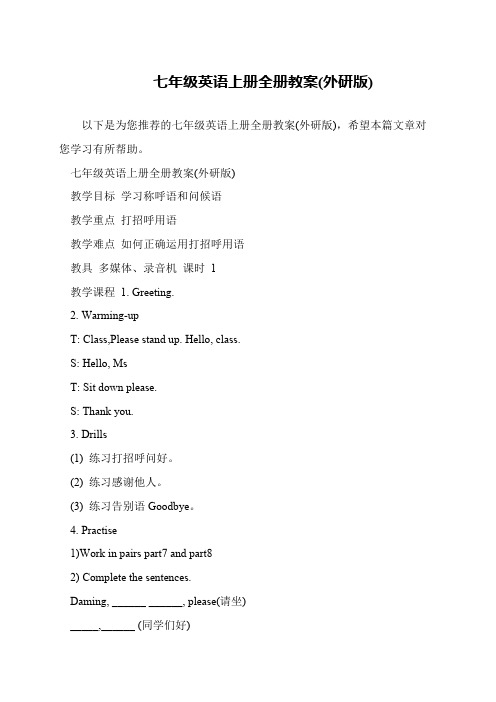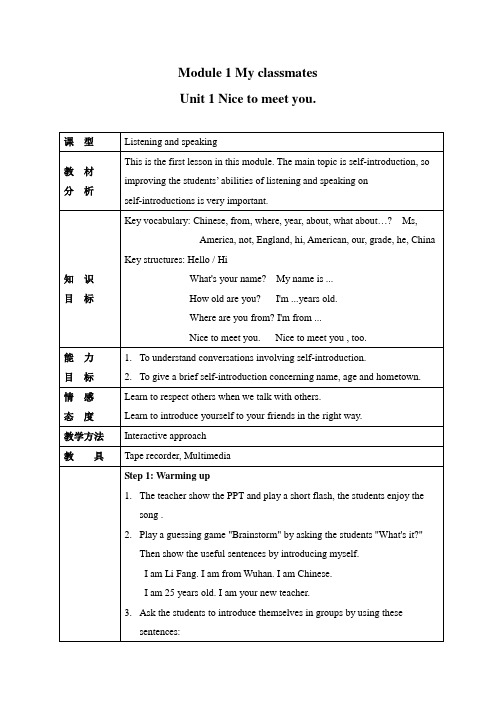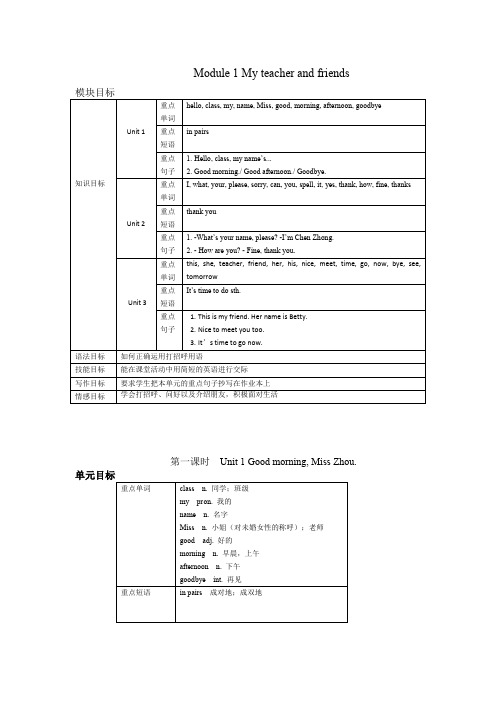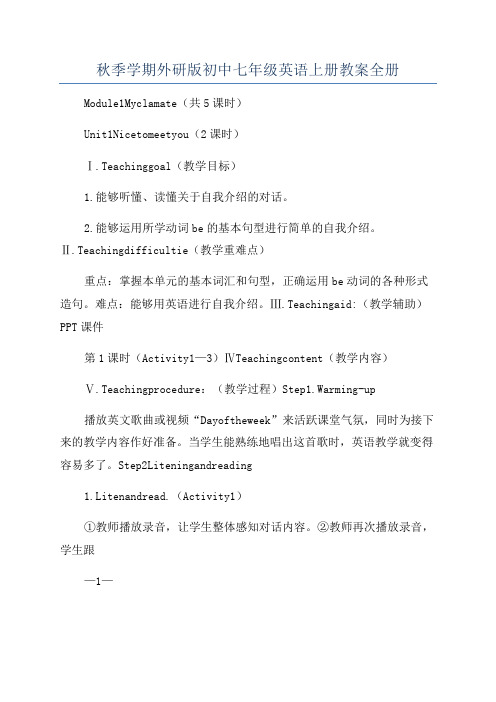外研版七年级英语上册教案全集
外研版英语七年级上册教案合集(全册)

Module 7 ComputersUnit 1 How do I write my homework on the computer?初一英语外研版(上)教案Module 8 Choosing presents一、学习目标:1.单词和短语:card, party, present, would, always, great, cake, never, special, eat, give, sing, happy, secret, CD,cinema, concert, magazine, scarf, silk, shirt, T-shirt, choose, exercise, wear, expensive,clothes, shoes, spend, money, film, song, match, weekend, at weekends, dear, hear, hear from,afraid2.交际用语:1)—Would you like to come to my birthday party?—Yes, I’d like to. When is it?2) Great!3) It’s a secret.3.重点句子:1) Daming always gets birthday presents!2) She often goes to the cinema.3) What do you usually do at a Chinese birthday party?4) We sometimes give birthday cards.5) My mother never makes a birthday cake.二、重点及难点:1.频度副词的使用及在句中的位置。
2.动词第三人称单数形式。
I always like birthday parties.三、教学设计:Unit 1 I always like birthday parties.ⅠTeaching modelListening and speakingⅡTeaching methodInteractive approachⅢTeaching aims1. To get to know the adverbs of frequency.2. To understand conversations involving “Daming’s birthday”.3. To be able to pronounce the third person singular endings4. To be able to describe what people do on their birthdayⅣTeaching ObjectivesKey vocabulary: card, party, present, would, always, great, cake, never, special, eat, give, sing, happy, secretKey structures:1)Would you like to come to my birthday party?2) I always like birthday parties.3) What do you usually do at a Chinese birthday party?4) My mother never makes a birthday cake.5) We sometimes give birthday cards.ⅤTeaching aidsTape recorder,OHP,video, handoutⅥTeaching StepsStep 1 Warming-up1. Show some picturesof birthday and say what they are.Key words:birthday , birthday card , birthday party , birthday cake , birthday presents , have a party , make a cake , eat noodles, eat birthday cake, sing Happy Birthday song…2.Match the words with the pictures.3. Read the words after the teacher.4. Introduce the new words.5. Enjoy a song: Happy birthday.Step 2 Listening practice.1. Make sure the students understand the symbols they must use to complete the chart2. Play the recording through once while they just listen.3. Ask the students to listen to the recording.4. Play the recording again, then they can check their answer with a partner.5. Call back the answer from the whole class and check the answer.Step 3 Work in pairs.Say what you always / usually / often / never do on your birthday.1. Read through the verbs and have the students repeat them. Make sure theyunderstand them.2. Ask the students to think about what they do, and make a list using the adverbs of frequency individually.3. Pair them to talk about what they do.4. Call back the answer from the whole class and check the answer.Step 4 Listen and read.1. Ask the students to read the conversation silently.2. Play the recording and ask the students to listen and read the conversation.3. Read the conversation.4. Act it out.Step 5 Check (√) the true sentences.1. Ask the students to read through the sentences and have the students follow and /or repeat.2. Play the recording again, then they can check their answer with a partner.3. Call back the answer from the whole class and check the answer.Keys:1. √2. ×3. ×4. √5. ×4. Correct the false sentences.5. Call back the answer from the whole class and check the answer.Step 6 Underline the correct words.1. Ask the students to read through the passage.2. Underline the correct words.3. Call back the answer from the whole class and check the answer.Keys: 1. special 2. cut3. presentsStep 7 Complete the sentences with the words from the box.1. Ask the students to read through the sentences.2. Complete the sentences with the words from the box with a partner.3. Call back the answer from the whole class and check the answer.Keys: 1. always 2. usually 3. never 4. sometimesStep 8Listen and repeat.1. Play the recording once without stopping.2. Ask the whole class to repeat.3. Ask the students to practice the sounds in pairs.Step 9 Work in pairs.Ask and answer like this:—What do you often / usually / always /… do on your birthday?—I often / usually / always /… on my birthday.—What do you often / usually / always /… do on Teachers’ Day?—I often / usually / always /… on Teachers’ Day.Step 10Grammar1. 动词第三人称单数词尾变化有三种形式。
七年级英语上册全册教案(外研版)

七年级英语上册全册教案(外研版)以下是为您推荐的七年级英语上册全册教案(外研版),希望本篇文章对您学习有所帮助。
七年级英语上册全册教案(外研版) 教学目标学习称呼语和问候语 教学重点打招呼用语 教学难点如何正确运用打招呼用语 教具多媒体、录音机课时1 教学课程1. Greeting. 2. Warming-up T: Class,Please stand up. Hello, class. S: Hello, Ms T: Sit down please. S: Thank you. 3. Drills (1) 练习打招呼问好。
(2) 练习感谢他人。
(3) 练习告别语Goodbye。
4. Practise 1)Work in pairs part7 and part8 2) Complete the sentences. Daming, ______ ______, please(请坐) _____,______ (同学们好) ______(你好).Jack. _______,_______ (谢谢), Miss Li. _______(再见), Lucy. 5. Conclude 6. Homework Complete part5 and part 6 个人修改 课后评价 教案 课题Starter Module1 Unit2 课型listeningandspeaking 教学目标学习打招呼的用语,询问姓名和相互间的问候。
教学重点打招呼用语,询问对方姓名的特殊疑问句及回答。
教学难点一天中不同时间的打招呼用语 教具多媒体、录音机课时1 教学课程1.Greeting. 2.Warming-up T: Good morning.What’s your name? S: I’m / My name is T: How are you? S: Fine, thank you. And you? T: I’m fine. too. 3.Drills 1)练习打招呼的用语Good morning/Good afternoon/Good evening。
外研版初中英语七年级上册教案全册

外研版初中英语七年级上册教案全册教案简介本教案是针对外研版初中英语七年级上册编写的一套全册教案。
全册共包含教学大纲、教学目标、教学内容、教学流程等内容,旨在提供给教师进行教学准备和教学实施的参考。
教学大纲- 介绍初中英语七年级上册的教学目标和教学内容- 探讨教学方法和教学评估方式- 安排教学时间和课程进度教学目标- 培养学生的听、说、读、写和翻译能力- 培养学生对英语研究的兴趣和积极性- 培养学生的跨文化交际能力教学内容- 课文研究:涵盖了各个主题的课文,如自我介绍、家庭、学校、食物、颜色、时间等- 词汇和语法:研究基本的词汇和语法知识,如动词、名词、形容词、冠词、介词等- 听力和口语:通过听力练和口语对话,提高学生的听力和口语表达能力- 阅读和写作:通过阅读文章和写作练,培养学生的阅读和写作能力教学流程1. 准备:教师准备教学材料、课件以及其他辅助教学工具2. 导入:通过与学生的交流、图片展示等方式引入课题,激发学生的研究兴趣3. 研究:根据教学大纲和教学内容,进行课文研究、词汇和语法讲解、听力和口语练、阅读和写作训练等4. 巩固:通过练、活动和游戏巩固所学知识,帮助学生加深理解和记忆5. 总结:对本节课进行总结,帮助学生归纳所学的重点和要点6. 作业:布置适当的作业,巩固学生的研究成果7. 反馈:对学生的作业进行评改,并给予相应的反馈和建议教学评估- 通过课堂表现和讨论,评估学生的理解和掌握程度- 通过口语和写作练,评估学生的语言表达能力- 通过考试或测验,评估学生的研究成果以上是对外研版初中英语七年级上册教案全册的简要介绍,希望能对教师们的教学工作提供一定的参考和帮助。
> 注意:以上信息是根据您提供的标题内容进行编写,具体教案的内容和安排可能需要您根据实际需要进行制定和调整。
外研版初中七年级上册英语教案全册

Module 1 My classmates Unit 1 Nice to meet you.教学过程教学过程What's your name? Where are you from?How old are you? Which class are you in?Nice to meet you.Step 2: Listening1.Play the recording in activity 1 and ask the students to listen and checkhow many people speak.2.Play it again and ask the students to check the words their hear.3.Check the answers with the whole students.Step 3: Listen and read1.Play the recording in activity 3 and ask the students to listenand answer the questions. Then check the answers.(1) How many people speak in the conversation?(2) Who are they?(3) Are they in the same class?2.Play it again and check the true sentences in act3. Ask somestudents to correct the wrong ones.3. Put the students into groups of four to practise the dialogue.The students repeat it several times, changing roles each time.4.Talk about the pictures in the PPT and show their performances.5.Ask the students to sum up the useful sentences in the dialogue andintroduce “Everyday English.”6.Finish act 4 and 5 in groups. Teacher checks the answers.Step 4: Pronunciation1.Explain that this activity focuses on some English phonemes which aredifficult to pronounce for speakers of Chinese.2.Play the recording once without stopping.教学过程3.Play it again and ask the students to repeat.4.Practise the sounds in pairs, then finish the exercises on the PPT.Step 5: Speaking1.Talk about the pictures by asking and answer in paris like this:A: What’s his name?B: His name is….A: Where is he from?B: He's from….A: How old is he?B: He's ...years old.Step 6: Module taskTask 1: Who has the most friends?运用本课句型,在规定的八分钟时间内,以小组为单位,看谁结交的朋友最多,她将获得一份丰厚的奖品。
外研版初中英语七年级上册全册教案版本1新版

外研版初中英语七上全册教案目录Module 1 Nice to meet youModule 2 Me, my parent and my friends Module 3 My new schoolModule 4 FamilyModule 5 Healthy foodModule 6 An invitation to the cinema Module 7 My school dayModule 8 Different habitsModule 9 A trip to the zooModule 10 ComputersModule 1 Nice to meet youII. Teaching material analyzing 教材分析本模块以“Introducing yourself”为话题,重点学习一般现在时S+be结构,介绍姓名、年龄、来自何地的表达法以及英美国家姓名的不同表达方式。
Unit 1 重点学习介绍、询问个人信息的方法。
其中活动1、3、4要求学生通过听力、读图识别词汇的方式初步学习有关人物介绍的方法。
活动5要求以pairwork形式掌握自我介绍和信息获取的交际技能。
活动6、7要求掌握本单元的语音和词汇并能在课堂交际中运用。
活动8要求将词汇和图片匹配,然后通过小组活动,以听和做的形式巩固这些词汇。
Unit 2 主要通过阅读和写作活动学习介绍个人信息的方法。
活动1通过问答练习复习前一单元所学获取和介绍个人信息的交际技能。
活动2、3要求学生阅读有关自我介绍的三篇短文并完成正误判断、填写表格两个任务。
活动4—6要求学生根据所学知识写句子介绍自己或他人的信息,并学会运用and连接这些信息。
Unit 3 对“自我介绍和获取信息”的功能句式进行综合训练:谈论自己或朋友的情况(活动1);根据提示完成介绍图片中人物情况的句子;填表、匹配复习表示国家、民族及人物活动的词汇。
Around the world了解中西人名的不同;Module task要求通过问答形式介绍自己和他人。
外研版七年级英语上册全部教案

Module 1 My teacher and friends第一课时Unit 1 Good morning, Miss Zhou.环节1 新课导入教师想学生作自我介绍,说“My name’s...”引导学生说出“Good morning, Miss/Mr...”。
教师可以让一部分学生用“My name’s...”作自我介绍,然后教师用“Hello,...”来问候学生。
教师请学生互相作自我介绍并问候,让学生迅速熟悉起来,感受到新集体的温暖。
设计意图:以自我介绍和问好的形式进行教学,能帮助学生尽快了解老师和同学的情况,消除距离感。
环节21.教师在黑板上画一个升起的太阳并标注时间,或用PPT呈现。
2.教师板书“Good morning”并领读这个句子。
3.教师播放录音,让学生边看、边听,跟读、模仿,认真体会这些语言在什么样的语境下使用。
4. 根据学生情况,重复播放录音2-3遍,让学生模仿。
5. 学生个体活动,完成匹配。
6. 教师播放录音,学生核对答案。
7. 教师让部分学生重复答案,关注并及时纠正学生的不准确发音。
8. 学生两人一组,练习问候语言,教师提醒学生用自己的真是姓名。
9. 教师在屏幕上随机呈现不同的时间场景,让学生练习,以检查学生的掌握程度。
10. 教师播放录音,学生认真听并跟读。
11. 教师让部分学生读字母,教师帮助纠正发音。
12. 教师让学生完成字母表的书写,提醒学生关注大小写字母。
13. 教师播放录音,提醒学生不要急于动笔,养成良好的听的习惯。
14. 教师播放录音,让学生边听边写,注意书写的规范和整齐。
15. 学生两人一组核对答案,并对对方的书写给予评价。
板书设计练习设计请完成本课对应训练!第二课时Unit 2 Good morning. I’m Chen Zhong.单元目标教学过程环节1 新课导入课前播放小学阶段学过的歌曲Hello和Good morning渲染气氛,同时复习上一节课学过的句型。
外研版初中七年级上册英语教案全册

Module 1 My classmates Unit 1 Nice to meet you.教学过程教学过程What's your name? Where are you from?How old are you? Which class are you in?Nice to meet you.Step 2: Listening1.Play the recording in activity 1 and ask the students to listen and checkhow many people speak.2.Play it again and ask the students to check the words their hear.3.Check the answers with the whole students.Step 3: Listen and read1.Play the recording in activity 3 and ask the students to listenand answer the questions. Then check the answers.(1) How many people speak in the conversation?(2) Who are they?(3) Are they in the same class?2.Play it again and check the true sentences in act3. Ask somestudents to correct the wrong ones.3. Put the students into groups of four to practise the dialogue.The students repeat it several times, changing roles each time.4.Talk about the pictures in the PPT and show their performances.5.Ask the students to sum up the useful sentences in the dialogue andintroduce “Everyday English.”6.Finish act 4 and 5 in groups. Teacher checks the answers.Step 4: Pronunciation1.Explain that this activity focuses on some English phonemes which aredifficult to pronounce for speakers of Chinese.2.Play the recording once without stopping.教学过程3.Play it again and ask the students to repeat.4.Practise the sounds in pairs, then finish the exercises on the PPT.Step 5: Speaking1.Talk about the pictures by asking and answer in paris like this:A: What’s his name?B: His name is….A: Where is he from?B: He's from….A: How old is he?B: He's ...years old.Step 6: Module taskTask 1: Who has the most friends?运用本课句型,在规定的八分钟时间内,以小组为单位,看谁结交的朋友最多,她将获得一份丰厚的奖品。
秋季学期外研版初中七年级英语上册教案全册

秋季学期外研版初中七年级英语上册教案全册Module1Myclamate(共5课时)Unit1Nicetomeetyou(2课时)Ⅰ.Teachinggoal(教学目标)1.能够听懂、读懂关于自我介绍的对话。
2.能够运用所学动词be的基本句型进行简单的自我介绍。
Ⅱ.Teachingdifficultie(教学重难点)重点:掌握本单元的基本词汇和句型,正确运用be动词的各种形式造句。
难点:能够用英语进行自我介绍。
Ⅲ.Teachingaid:(教学辅助)PPT课件第1课时(Activity1—3)ⅣTeachingcontent(教学内容)Ⅴ.Teachingprocedure:(教学过程)Step1.Warming-up播放英文歌曲或视频“Dayoftheweek”来活跃课堂气氛,同时为接下来的教学内容作好准备。
当学生能熟练地唱出这首歌时,英语教学就变得容易多了。
Step2Liteningandreading1.Litenandread.(Activity1)①教师播放录音,让学生整体感知对话内容。
②教师再次播放录音,学生跟—1—读、模仿。
③学生两人一组练习对话。
④教师让不同的小组展示对话,关注学生的发音。
2.Litenandrepeat.Nowpoint,akandanwer.(Activity2)①教师放录音,学生听录音。
②教师再次播放录音,学生跟读、模仿。
③学生两人一组根据日历练习对话。
④教师让部分小组展示对话。
环节说明:本活动以日历的形式让学生学习表示星期一至星期日的7个词汇,然后指着日历上的具体日期来询问星期几,进而练习相关句型“Whatdayiittoday”教师向学生说明在西方国家Sundayithefirtdayoftheweek,让学生了解这种文化差异。
Step3Practice1.Readandmatch.Nowlitenandcheck.(Activity3)①学生个体活动,完成匹配。
- 1、下载文档前请自行甄别文档内容的完整性,平台不提供额外的编辑、内容补充、找答案等附加服务。
- 2、"仅部分预览"的文档,不可在线预览部分如存在完整性等问题,可反馈申请退款(可完整预览的文档不适用该条件!)。
- 3、如文档侵犯您的权益,请联系客服反馈,我们会尽快为您处理(人工客服工作时间:9:00-18:30)。
Unit 1 Nice to meet you教学流程图: 教学步骤 l (1课时)一、第一教学环节:情景创设、布置任务、激趣导入二、第二教学环节:师生互动、培养能力、给予成就感三、第三教学环节:评价总结、激发竞争、巩固提高附:评价表(小组成员之间进行评价,以星号为标记,五个星为最高,但是必须小组全票才能通过生效)Unit 2 I’m from China and I’m ChineseTeaching aimKnowledge: *useful expressions in introducing and greeting*nominal genitive pronoun & determinative genitive pronounAbilities: To be able to introduce oneself and others and greet peopleMoral education:To build up students’ confidence and interest in English- learning Key points: Introducing othersThis is Betty. This is my friend, Tony.Difficult points: 1) Asking for and receiving personal information.What’s your nameCan you introduce yourself please, BettyI’m from America. I’m 13 yea rs old.2) To master the names \ languages\ of some countriesTeaching methods: Group work, displayTeaching aids: Computer recorderTeaching procedures:Step 1 Teacher’s self-introduction (Lead-in)Name, Country, language, Age otherKey Sentence Structures:My name is ##.My first name is ##.My telephone number is ##.I’m from ##. I ‘m ##.My age is a secret.I am from Beijing. I come from Beijing. I am a native in Beijing.I come from China. I was born in China and brought up in China. I speak Chinese. In my spare time, I enjoy ###.My E-mail Address is ##.Step 2 Foreign teacher’s introduction (The same)This is our foreign teacher. (Name, Country, language, Age other) Students’ Activity: Listen and get some informationStep 3. The stud ents’ IntroductionNameAgeTeacherYearClassPhone numberE-mail addressCountryLanguageOtherListen and prepare the introduction.Introduce themselves according to the form.Pair work; Introduce themselves.Step 4. Part 2 on the book.Please listen to the tape so that we can know more about Daming, Lingling and Wang Hui. Please don’t open your books. Look at the blackboard.Listen and Answer.:1)Where is Daming from2)Where is Lingling from3)Where is Wang Hui from4)How old are theyName Country Language Age OtherBettyTonyLinglingWork in pairs to practise the dialogue.Students’activity: Listen to the tape; Practise their listening; Improve their abilities of get informationStep 5. Learning the dialogue.Practise the listening skill & Role playStudents’ activity: According to the form, they work in groups to practise the dialogue.Step6. Show a map of the world to practise the names \ languages of the countries Listen and think so many foreign countries’ names.Step7. Read aloudThe students read aloud to practise oral English.Write some sentences about the pictures.Step9. Learning the language item.1)My name’s … /I’m from…/He’s fourteen years old.2)The names of the countries.The students learn the language points.Homework: Introduce one of your pen-friends.Unit 3 Language in use学习目标:1.学习be动词的简单用法。
(参考书本P117-118)2.阅读P7 Around the world,知道西方人的姓、名位置given name(名/教名)+family name(姓)和中国人的姓名位置相反。
学习重难点:be动词变脸。
课前准备:1.你会说吗①-What’s your name-My name is…②-Where+is/are+主语+from -主语+am/is /are from…③-How old are you -I’m…(years old).④I’m a teacher and I’m Chinese.2.完成书本P6的第2、3部分。
3.完成书本P7的第4部分。
4. 才艺展示:找Partner运用第6部分的句子进行对话表演。
学习过程:1.Guess game:(1)采访2--3位同学。
(2)指一生介绍刚才采访的同学的情况,其他学生猜是哪一位同学。
2.预习检查及交流。
3.学习和操练大声朗读Language practice, 试述be动词的用法。
4.小结:动词be(am, is, are)的用法(具体参考书本P117-118)be的用法口诀5. 用be的适当形式填空。
(1)He ______ a teacher. His name _________Lin Feng.(2)—How old _______ Mingming and Dongdong--They ______ thirteen. They are only eleven.(3)--__________Becky from America--No, she _____________. She is from England.(4)Sam snd his friend Helen __________ in Class Two. They are in Class Three.(5)--___________Lucy and Lily twins--Yes,they are. And both of them _____________ twelve.(6)--___________ you a student--No, I ________ _________. I __________ a worker.课后延伸:一、单词拼写。
_______(第一)name is Jack.is a big ________(城市) in China.are all new___________(学生)in this school.is only six ___________(年)old.we learn____________(课) One.look at the ___________(黑板).( 匹配) the worlds with the pictures.( 二十九) is my lucky number.don’t have _____________(十四) apple.are _______________(十二)boys in my class.( 五十) chairs are in the class.二、填表:三、单项选择。
()'s your family name--_________.A. Petter HallB. Hall Petter()you friends--____________.A. Yes, we areB. Yes,I amC. No,we are ,you aren't ()is Mary and that is my _________.'s;friend 's;friend're; friends 's friends()and Tony _________ English.'t 't 't 't()are good friends.and I and Mike and me and MikeModule 2 Me, my parents and my friendsUnit 1 I can speak English.Module 2 Me, my parents and my friends Unit 2 These are my parents.Module 1 Nice to meet you Unit 3 Language in useModule 3 My new school I. Teaching goals 模块教学目标II. Teaching material analyzing教材分析本模块以“My new school”为话题,重点学习存在句There be 结构,介绍某地有某物、某物在何处以及方位,物体所属关系的表达法。
